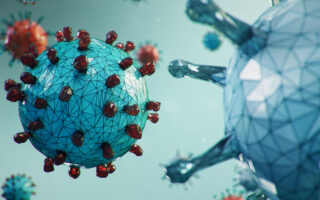The accelerated arrival of novel vaccines and immunotherapies into the clinical space spurred the emergence of fields like personalized medicine, immuno-profiling and immuno-monitoring built around increasingly sophisticated testing platforms. Among them, immunoassays in the ELISpot (Enzyme-LinkedImmunoSpot) family are the most frequently used functional assays for single-cell analysis.1
 Using 2017 data from Trialtrove (Citeline.com), we found that ELISpot assays were used in more than 160 open clinical trials (Figure 1). The main drivers for this rising clinical usage are:
Using 2017 data from Trialtrove (Citeline.com), we found that ELISpot assays were used in more than 160 open clinical trials (Figure 1). The main drivers for this rising clinical usage are:
- The increased prevalence of infectious and chronic diseases as the population ages in developed countries
- Extensive use of immunoassays in oncology new vaccines and immunotherapies
- Technological developments, such as test automation and rapid analysis
- Growth in the biotechnology sector
Looking for the Right Spot
In the ELISpot assay, cell-secreted analytes (cytokine, immunoglobulin, etc.) are captured by an antibody-coated membrane at the bottom of ELISA-like plates. After removal of cells, the captured analyte is visualized by deposition of a colored substrate, which results in the formation of spots on the membrane. Spots are a representation of cells that secrete the analyte of interest, the amount of analyte secreted and its kinetics.2The spots are then counted and quantitative reports are generated like the frequency of antigen-specific T-cells3following immunization or treatment.4The ELISpot assay where human interferon gamma is detected is the IFN-γELISpot assay.
IFN-γELISpot
The induction of a potent lymphocyte effector function is central to the activity of novel biological therapeutics. Due to its known role, IFN-γhas become a predominant marker for the induction of cellular immune responses.5-7Correspondingly, for the past two decades, the IFN-γELISpot assay is a highly sensitive yet “simple” platform to detect and quantify antigen-specific cellular responses. It has also become the benchmark for analysis of T-cell responses according to Good Clinical Laboratory Practice guidance.8It is used in vaccines, transplantation, HIV, cancer and allergy,4,5,6,7and more. The IFN-γELISpot assay carries nearly 55% of all ELISpot testing needs in ongoing clinical trial evaluation. Because of that, and the ongoing industry expansion into polyfunctional cell analysis,9,10much attention has been given to the quality of the IFN-γELISpot assay.
However, the simplicity of the IFN-γELISpot assay only seems apparent. Results from proficiency panels initiated by several organizations revealed drastic differences in the reported results by participant labs.11,12,13There are several strictly controlled variables that influence the assay outcome. Those include the test medium, the antigen (stimulus), cell storage conditions, cell viability, staff training levels and the actual counting and quantification approach of the ELISpot plates.
A Holistic Approach to ELISpot Development, Qualification and Validation
Successful implementation of any ELISpot testing solution during clinical trials does not happen in a vacuum if assay variables and sample integrity are to be kept in check. Part of theCovanceIFN-γ一个专门的Targete ELISpot集成解决方案d Cells Isolation team, who is responsible for processing/producing the cellular component that goes into the assay (peripheral blood mononuclear cells), T-cells, B-cells, etc.), avoiding costly sample processing, minimizing risk and additional fees incurred when shipping live frozen cells to different specialty laboratories.
Likewise, regulatory proficiency, global reach, proven logistics and a dedicated, scalable ELISpot solution with increasing testing volumes – according to the specific study needs – are all critical to the success of a clinical trial program using ELISpot. Covance, at its Central Laboratories (CLS), offers a wide array of tests in the areas ofgenomics,flow cytometryandhistology– all under one roof as these tests generate mutually complementary data to that of ELISpot assays. This enables sponsors to create functional immunoprofiles that capture the overall cellular immunity status of clinical trial subjects.
Covance has offered IFN-γELISpot testing for several years in ourTranslational Biomarker Solutions laboratories. However, and more importantly, Covance just added IFN-γELISpot capabilities at ourVaccine and Novel Immunotherapeutic Laboratory(within the CLS) in Indianapolis, offering sponsors a one-stop solution for any IFN-γELISpot assay in their clinical testing programs.
Positioned for the Future

In addition to the traditional colorimetric quantification of secreted cytokines, the Covance ELISpot platform allows for the development and execution of multiplexed FluoroSpot assays (Figure 2), the next-generation of ELISpot, which enables simultaneous measurement of different analytes.14,15The capability to validate novel FluoroSpot assays using a modular approach will allow for a “plug-and-play” flexible offering that will decrease development time for sponsor-specific antigens and targets. The ELISpot platform at Covance’s Vaccine and Novel Immunotherapeutic Laboratory is ideally positioned to support upcoming developments in the field.
References
1-Czerkinsky CC, et alJ Immunol Methods. 1983;65:109-121.
2- Karulin A.Y, Lehmann, PV.Methods Mol Biol. 2012;792:125-143.
3- Nanan R, et alJ Gen Virol. 2000;81:1313-1319.
4- Carvalho L.H, et al.J Immunol Methods. 2001;252:207-218.
5- Flynn K., et al.Immunity. 1998;8:683-691.
6- Bercovici N, et al.Clin Diag Lab Immunol. 2000;7:859-864.
7- Carter LL, Swain SL.Curr Opin Immunol. 1997;9:177-182.
8- Ezzelle J, et al.J Pharm Biomed Anal.2008;46(1):18-29.
9- Dillenbeck T, et al.Cells. 2014;3(4):1116-1130.
10- Gazagne A, et al. J Immunol Methods. 2003;283:91-98.
11- Janetzki S, et al.Cancer Immunol. Immunother. 2008;57:303-315.
12- Britten C.M, et al.Cancer Immunol Immunother. 2008;57:289-302.
13- Cox J.H, et al.AIDS Res Hum Retroviruses.2005;21:68-81.
14- Janetzki S, et al.Cells. 2014;3(4):1102-1115.
15- Gazagne A, et al.J Immunol Methods. 2003;283(1-2):91-98.












